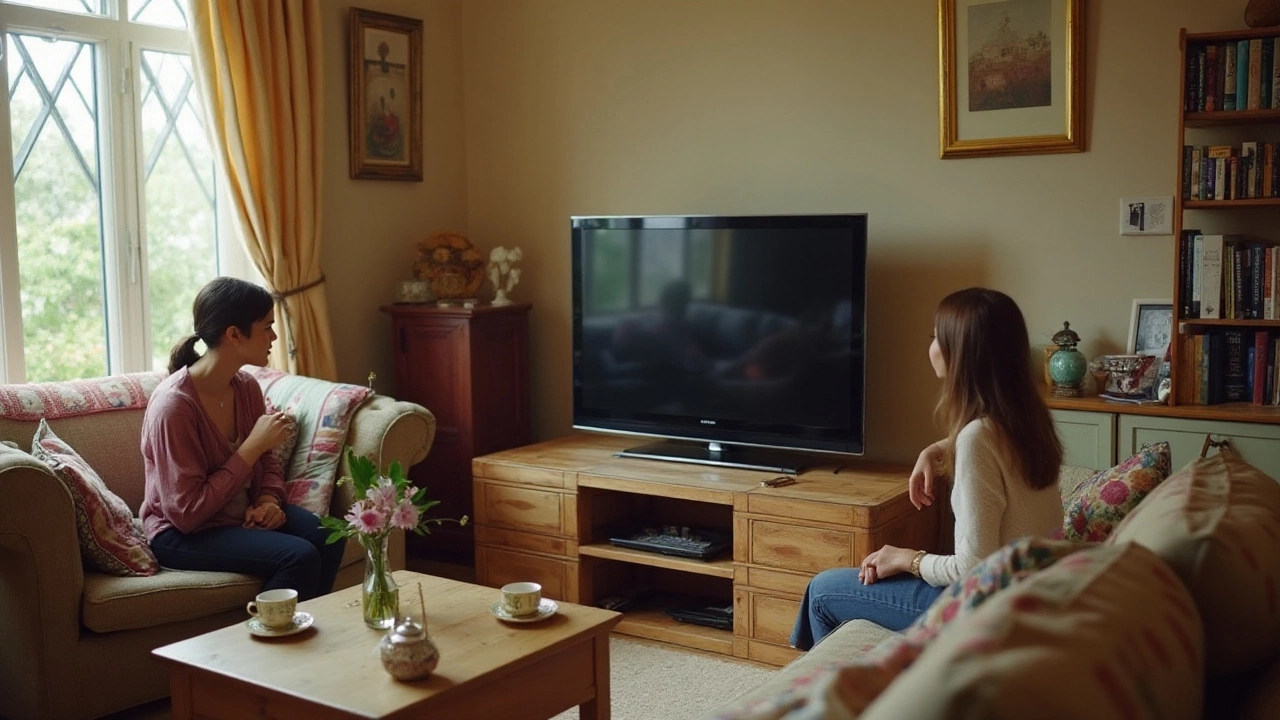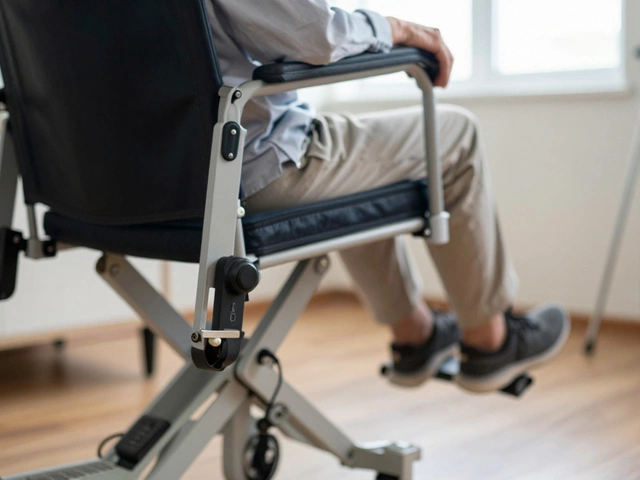 22
Oct,2024
22
Oct,2024
Have you ever moved your TV, only to realize those essential little legs have vanished into thin air? It’s an unsettling moment when, out of the blue, your television is rendered legless. But don’t sweat it! There are many ways to get your prized screen standing tall once more.
Whether you’re a DIY enthusiast ready to take matters into your own hands or you prefer purchasing replacements, there's a wealth of practical solutions. We’ll walk you through each step, considering factors like stability and safety, so you’re not just getting back to normal, but perhaps even improving your setup. So, let’s roll up our sleeves and explore how to give your TV the stand it deserves.
- Understanding Your TV Model and Stand Compatibility
- DIY Solutions for Missing TV Legs
- Purchasing Replacement Legs
- Ensuring Safety and Stability
- Creative Alternatives for TV Placement
Understanding Your TV Model and Stand Compatibility
When embarking on the mission to replace those elusive TV stand solutions, the first crucial step is getting to know the anatomy of your television model. Every TV is a unique piece of technology, much like how every person has distinct features. Even TVs of similar sizes can vastly differ in how they attach to stands or legs. Begin by locating the model number of your TV. This number is usually found on the manufacturer’s label or the back panel of the TV. Knowing this number can often be your gateway to understanding which type of replacement legs or stands are compatible.
Understanding your TV's unique design features can save a lot of time and effort. For instance, some televisions are designed to fit onto specific branded stands or legs, while others might use a more universal fitting. Modern TVs often make use of VESA (Video Electronics Standards Association) mounting patterns. This universal standard can make life much easier as it allows for easier matching of legs or brackets, particularly when you’re on the hunt for missing TV legs.
There is also an element of safety to consider. A TV that’s improperly or precariously perched can pose a significant safety hazard, especially in homes with children or pets. According to Safe Kids Worldwide, roughly 17,000 children are treated in emergency rooms every year for television-related injuries. In understanding your TV's compatibility with stands, you not only aim to perfect the aesthetic setup but also ensure your living area remains safe and sound. It's that blend of function and style that brings harmony back into your TV watching experience.
"Matching your TV model with the correct stand is like ensuring a tight fit for a jigsaw puzzle piece; perfectly snug and satisfyingly secure," notes Susan Miles, a home safety expert.
Researching ahead of a purchase may involve reviewing the instruction manual that came with your TV or browsing the manufacturer’s website for specific guidelines they provide. Many TV manuals offer detailed insightful advice about the TV furniture repair aspects, including compatible mounting equipment, which can sometimes include alternative leg models or authorized replacement parts. Exploring these resources can provide a pathway not only to an effective and cost-efficient solution but also an educational dive into the specifics of your television’s technological design.
DIY Solutions for Missing TV Legs
There’s a special kind of satisfaction that comes with fixing problems using your own two hands. If your TV is missing its legs, don’t worry—you have more control over the situation than you might think. Let's delve into some innovative DIY methods to get your TV standing proud once more. One easy option is to repurpose materials you might already have at home. For instance, thick books or wooden blocks can be improvised as a temporary solution. Ensure whatever you use is sturdy, similar in height, and placed securely at both ends. This might sound unconventional, but it has been a go-to for many.
You can also create customized legs using basic tools and materials. If you have access to a hardware store, consider buying adjustable furniture legs or aluminum braces. These can be attached to the back of the TV with some screws. If the back of your TV doesn’t have screws or brackets, it might require additional creativity such as using adhesive brackets or industrial-strength velcro. According to a DIY enthusiast, "Having the right tools on hand can turn any situation around. I’ve used plywood, cut into equal blocks, to replace a missing TV stand—painted them black, and my TV looked as good as new!"
Another idea is recycling unused furniture parts. Got an old stool or a broken table? You could salvage the legs from these items. Often, all it takes is a bit of patience and the right screws or hinges to repurpose these into TV stand legs. Remember, it’s key to ensure the materials match the weight and size of your TV for optimal balance. As you explore these ideas, consider including a rubber grip under your DIY legs to prevent any unwanted sliding on smooth surfaces. This adds an extra layer of stability and safety.
Let’s not forget about the potential of the PVC pipe. A favorite among DIY communities, PVC pipes are cheap, easy to cut, and highly customizable. You can paint and adjust the height to your preference, ensuring your TV sits perfectly. Just slice them to the required length with a saw, and you’ve got uniquely crafted legs for your setup. This material's flexibility allows you to experiment with angles and designs, so you can showcase your creativity. Be proud of your creation because DIY is not just about problem-solving—it's a form of self-expression.

Purchasing Replacement Legs
Once you’ve decided to replace the missing legs of your TV rather than crafting a homemade solution, the idea of buying replacements can sound very appealing. First, you need to identify the exact model of your television, which is usually indicated on the back of the unit or in the user manual. With more manufacturers producing unique fixtures, compatibility is crucial to ensure your new legs fit snugly. Websites like Amazon or eBay offer a wide range of options, often including universal stands that promise compatibility with almost any TV model. Read reviews from previous buyers to sift through the multitude of products and choose reliable leg replacements that won’t let you down.
Don’t overlook the manufacturer’s website, as they might offer direct options for replacement. For brands like Samsung or LG, they list their replacement parts in the support section. This route might take a bit longer, but purchasing directly from the source ensures that the quality matches the rest of your setup. While replacement legs from the manufacturer can sometimes be pricier than third-party parts, consider the long-term investment to prevent any wobbling disasters.
Exploring local electronics or furniture stores can also offer quick solutions. Stores might have generic stands on hand, which can save time compared to waiting on shipping. Also, speaking to a knowledgeable salesman might help you identify unique solutions that you hadn’t considered before. Remember to bring the make and model information with you, as it will make your search more efficient.
While exploring these options, it’s worth understanding that prices for replacement TV legs can widely vary. In some instances, the cost might rival that of a new, budget TV stand which can bring added advantages like storage or cable management facilities. In fact, a survey conducted by the Consumer Technology Association found that television stands are increasingly seen as an integral part of home décor and not just functional.
The New York Times once mentioned, "When choosing replacement legs, consider whether it's better to refurbish or renew – sometimes the most practical choice isn't what you expected.”
Ensuring Safety and Stability
When replacing or improvising TV stand solutions, safety and stability should always be at the forefront of your mind. A teetering TV isn't just a minor nuisance; it poses significant risks to both the device itself and everyone in the household. Consider the weight and size of your television. Modern TVs vary greatly in design, from ultralight designs to sturdier models. Ensuring that your stand or legs can support the full weight is crucial to avoid tipping over.
One known method to test stability is by gently nudging the TV at different points. If it sways or rocks, that's a red flag indicating you need to bolster the support. Secure fastening mechanisms are essential; screws should be screwed in properly and checked regularly. It's not uncommon for vibrations, especially in homes with active households, to slowly loosen screws over time. Tightening them can prevent unexpected TV tumbles, safeguarding both your investment and your peace of mind.
Creating a safe setup also involves considering the environment around the TV. Ensure that cords and cables are neatly arranged and not causing any imbalance. Cable management might seem like a minor detail, but tangled cords can sneakily tug on the TV, pulling it off balance. An array of clips, ties, and covers are available to keep these cords in check and out of harm's way.
For those attaching their TVs to walls or any elevated TV furniture repair, wall-mounts should comply with VESA standards. These standards ensure a snug and precise fit, crucial for the integrity of the mount itself. Misaligning even a little during installation can lead to high stress on certain parts of the TV's body or the wall, which, over time, might result in catastrophic failure. Consulting with professional installers or referring to mounting manuals can vastly reduce such risks.
According to a report by the Consumer Electronics Association, over 50% of TV accidents can be attributed to poor mounting or inadequate stands. The report highlights the minute details, often overlooked during installation, leading to mishaps.
Lastly, consider your household's unique needs. Families with small children or pets should be especially vigilant. Waist-level TVs or those at reach of curious little fingers should be anchored securely. Corner mounts are adjustability-savvy solutions for such homes, reducing risks without impeding viewing angles. Ultimately, taking a few extra precautions during the setup process can save a lot of trouble in the long run. From a simple routine check to more comprehensive safety measures, every bit counts in achieving a stable and worry-free TV experience.

Creative Alternatives for TV Placement
When life throws a curveball like missing TV legs, it's time to get innovative. Rather than seeing it as a setback, think of it as an opportunity to reimagine your living space. One popular option is wall mounting, which not only saves floor space but also provides a sleek, modern look. You need to find a sturdy wall mount that fits your TV size and weight. Professional installation might be wise if you are not handy with tools, ensuring that your device remains secure and damage-free. Once your TV is on the wall, you can rearrange furniture to create a cozy viewing area that feels entirely new.
If wall mounting isn't feasible, look to existing furniture for DIY TV stand solutions. Almost any flat surface at a suitable height could work in a pinch, such as a console table or a dresser top. By anchoring your TV to the surface with safety straps or brackets, you ensure it stays put. Adding a couple of stylish storage baskets around the base gives you space for cables, remote controls, and devices, keeping everything tidy.
Some folks find satisfaction in going all out with custom-built solutions. If you're handy or know someone who is, consider building a simple wooden stand or platform to rest your TV on. Measure the dimensions of your screen and craft a base that not only supports it but complements your room's decor. Adding wheels or casters to such a setup can provide portability, letting you reposition the TV as needed, whether you're entertaining guests or enjoying a quiet evening at home.
Innovative Shelf Solutions
Don't underestimate the power of shelves when it comes to TV placement. A well-placed expansive bookshelf or floating shelf can not only accommodate your TV but also display your favorite mementos or act as additional storage. When selecting shelves, ensure they are robust enough to support your TV's weight. Structurally sound materials like oak or metal brackets ensure the safety of your set. Incorporate LED backlighting for an ambient effect, enhancing your overall viewing experience by reducing glare and creating a cinematic vibe.
Another out-of-the-box idea is to use easel-inspired stands, which could bring an artistic touch to your living room. These tripod-like structures often have a rustic charm and provide easy height adjustment. Many interior designers laud this approach for its blend of style and functionality. As interior designer Nate Berkus puts it,
"The television should never dominate the room. It should complement the space, much like a piece of art."With this mindset, an easel stand can turn your TV into the focal point without overshadowing the other elements of your home.
To give you a sense of how versatile these solutions can be, consider arranging your TV in various rooms beyond the living area. Kitchens, bedrooms, and even bathrooms can benefit from creative TV placements. Just ensure you account for factors like moisture and heat that might affect the screen. By thinking out-of-the-box and leveraging available resources, you might find these TV stand solutions even more appealing, giving your home a refreshed and contemporary look.




